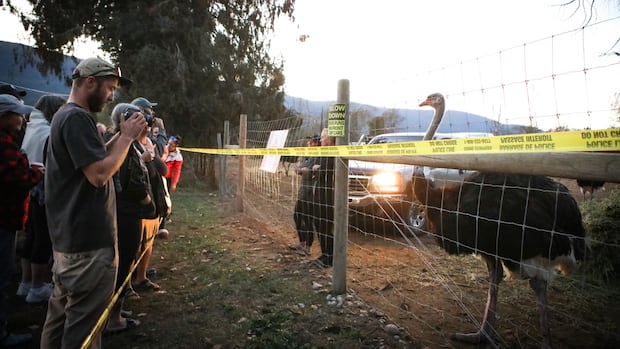British ColumbiaThe Canadian Food Inspection Agency says the “ongoing delay” in carrying out the cull of ostriches at a British Columbia farm presents “potential animal and human health risks.”Food inspection agency says it has identified 1 ostrich on site ‘with compromised health’The Canadian Press · Posted: Sep 26, 2025 1:14 PM EDT | Last Updated: 1 hour agoSupporters of Universal Ostrich Farms gathered in Edgewood, B.C., on Sept. 22 to protest a cull order. That order has now been granted a temporary stay. (Aaron Hemens/The Canadian Press)The Canadian Food Inspection Agency says the “ongoing delay” in carrying out the cull of ostriches at a southeastern B.C. farm presents “potential animal and human health risks.”The agency said in a statement that it will continue to feed the birds under veterinary oversight, and it will be using the feed provided by Universal Ostrich Farms’ regular suppliers.The statement said it has determined there are between 300 and 330 ostriches on the farm in Edgewood, B.C., and work on determining a more precise count is ongoing.The agency also said it has identified one ostrich on-site “with compromised health” but it didn’t say what is wrong with the bird. The birds on the farm have been given a temporary reprieve after the Supreme Court of Canada issued a last-minute stay of the cull earlier this week.The cull was ordered after an outbreak of avian flu at the farm, but the farm’s owners have challenged the move saying the birds that survived are healthy and scientifically valuable.The CFIA said that following confirmation of the outbreak, a laboratory in Winnipeg isolated the virus and complete whole genome sequencing.Ostriches eat their feed at the Universal Ostrich Farms in Edgewood, B.C., on May 17, 2025. (Aaron Hemens/The Canadian Press)It said the virus is a “novel reassortment” not seen elsewhere in Canada, including a genotype that has been associated with a human infection in a poultry worker in Ohio.”Laboratory analysis also found this novel reassortment event has enhanced the pathogenicity of this particular H5N1 genotype,” the statement said.”Even minimal quantities of the virus could be lethal, with a rapid time to death of 4-5 days in mice exposed to even low doses. By comparison, the B3.13 genotype (originating from a USA dairy cow) resulted in mortality within 3-6 days, but only at substantially higher doses.”
Stay of ostrich cull in southeast B.C. an ongoing potential health risk, CFIA says











